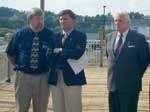|
Dock of the Bay
 People Just Can’t Keep Their Hands off the New Sculptures on Millennium Trail People Just Can’t Keep Their Hands off the New Sculptures on Millennium Trail
Sculptures that please kids and art-lovers alike have carved trail-side niches in Annapolis. Walk down the Annapolis Colonial Maritime Trail beside Chesapeake Children’s Museum and you’ll encounter not only a 10-foot-long wooden salamander but also a carved sea monster rising from the ground beside a simple workboat.
This is the first of three Trail Art Projects to grace the route of our Maryland Millennium Legacy Trails, comprised of the BWI Trail, the B&A Trail and the Annapolis Colonial Maritime Trail.
“All three art projects are different in their moods, but all are under the theme of Maryland in Motion,” says Elizabeth Wyble, project manager of Maryland Millennium Legacy Trail Art Project, sponsored by Friends of Anne Arundel County Trails.
Funding from grants from the National Endowment of the Arts, The Maryland State Arts Council, TKF Foundation and Maryland Department of Transportation allowed The Friends of Anne Arundel County Trails to select three artists for its trails.
For the five-piece grouping at the Chesapeake Children’s Museum, they chose Jacquin Smolens of Rock Hall, a sculptor for more than 40 years.
“I wanted to make sure that the pieces were humorous and interesting enough for kids,” said the bearded woodcarver.
Clear, fall weather, music and trail-mix made for a sunny unveiling of Annapolis’ newest public art collection on September 23. During the ceremony, the Trail Friends handed over the sculptures to the city of Annapolis.
“The pieces are so symbolic; we are friendly to our creatures here in the city,” said Annapolis Mayor Ellen Moyer, who joined in the welcome celebration.
Smolens’ wooden works include Chessie the Sea Monster, a workboat, a round-shell turtle, an osprey and a beaver with freshly gnawed tree stump.
To create the sculptures, Smolens uses a variety of hardwoods: maple, white ash, sycamore, English elm and Norway maple. He shuns softwoods, like pine.
“All the wood is from Baltimore City,” said Smolens. The wood — from trees removed from Baltimore parks, the zoo, and streets — has been stored in piles that Smolens could draw from. Once Smolens chooses his logs, he begins his work.
“He’ll size up a tree first and see what he wants to do with a particular piece of wood,” said Keith Madsen, a friend of the artist.
Then, said Smolens, “Old chainsaw Jack gets busy and pieces start to fly off.”
After cutting his creations loose with a chainsaw at his studio in Rock Hall, he carved final touches at Chesapeake Children’s Museum. A wood preservative finishes the sculptures, ensuring that children will explore these works of art for 25 years to come.
 His woodworks are as much about touch as sight. His woodworks are as much about touch as sight.
“Put your hand on each piece,” says Smolens, “so you can understand how the grain of the wood can be exceptionally intricate.” His sculptures, meant for kids to climb on, are low to the ground, inviting kids young and old to clamor atop. Chessie the Sea Monster even has handholds to help kids up onto its back.
Annapolis kids wasted no time in exploring the new trail art. Just after the dedication ceremony, they were already climbing on Chessie and snacking on trail-mix aboard the workboat.
“It invites kids immediately to climb and interact on it,” says Children’s Museum director Deborah Wood. “It speaks to the kids and becomes a lasting memory.”
—Carrie Steele
to the top
 |
| photo courtesy of Chesapeake Beach Railway Museum |
State Funds 1.4-Mile Trail
The railway brought life to Chesapeake Beach in the early 20th century. That era ended in 1935, when the Chesapeake Beach Railway shut down service.
Now, 104 years after its first use, the old railway will again bring people into town.
Instead of 8,000-ton steam locomotives packed tight with summer vacationers, the old track bed will carry walkers and bicyclists into town to shop, eat and socialize.
Beginning in the summer of 2006, walkers will follow the 1.4-mile, eight-foot-wide hiker-biker trail east from the Richfield Station community along to Fishing Creek, down to Kellam’s Recreational Center and the main thoroughfare of the Twin Beaches, Rt. 261.
 |
photos by Louis Llovio
Gov. Robert Ehrlich, center, joined state Senate president Mike Miller, right, and town councilman Bruce Wahl to unveil plans for a new trail along the old route of the Chesapeake Beach Railway. |
Chesapeake Beach bills the trail as a “safe and healthy alternative to get into town to run errands and enjoy lunch or dinner.” The trail ends at the Chesapeake Railway Museum. Lunch or dinner can be had at one of several restaurants surrounding the museum or across Rt. 261.
Construction on the $3.26 million Chesapeake Railway Trail begins in the fall of 2005.
Funds for the trail are part of a $28 million transportation package for Calvert County announced by Republican Gov. Robert Ehrlich on a visit to town last week. Chesapeake Beach, a Democratic stronghold, wins big with $7.9 million.
“I want to thank everybody who made this possible,” said Chesapeake Beach mayor Gerald Donovan.
State and county leaders who put the package together came out in force for the announcement. Among them were Democrats Senate President Mike Miller, new Del. Sue Kullen, former delegate George Owings and North Beach Mayor Mark Frazer. Only the Calvert County Council, with four Republicans to one Democrat, gave the bipartisan balance that Ehrlich praised.
“This is a big day,” said Donovan. “No one could have imagined [it] happening on June 4, 1900, when Chesapeake Beach Railway depot opened.”
—Louis Llovio
to the top
 Help a Tree Nursery Not Only Squirrels Are Gathering Nuts Help a Tree Nursery Not Only Squirrels Are Gathering Nuts
Should you find yourself competing with squirrels this fall, it’s all for a good cause. Golfball-sized black walnuts and marble-sized acorns are in demand. Seeds such as these create forests.
No more running over nuts with your lawnmower or stepping on them with bare feet. Two or more bushels of black walnuts can bring the Department of Natural Resources’ Forest Service right to your doorstep to take them off your hands.
DNR wants your black walnuts to sprout and grow at the John S. Ayton State Forest Tree Nursery in Preston. The nursery will then sell the two-year-old, 18- to 24-inch-tall saplings to Marylanders for reforestation.
“It’s not easy to pick up walnuts with our machines,” said Brian Stupak, forester for the Department of Natural Resources. “Black walnuts take lots of manual labor; having landowners donate helps us out.”
Don’t bother collecting acorns, however. The Forest Service can pick them up just fine by machine.
In this initial year of citizen gathering in Anne Arundel and Calvert counties, DNR plans to collect 3,000 pounds. From that number, “It’s hard to say how many will sprout,” Stupak said. The Forest Service does know that your help will grow trees.
Saplings from the nuts you collect will reforest private land throughout Maryland. The trees will be sold to private landowners planting more than an acre rather than a tree or two for landscaping.
“If you had an old field you wanted to convert back into woods,” says Stupak, you’d be the customer DNR is looking for.
But that’s a year or two down the road. First comes the harvest.
No walnut trees? You can still take part in the 2004 nut harvest at DNR’s Growing Native events.
Last year Growing Native gathered 20,000 pounds of seeds, acorns and walnuts to raise for watershed conservation.
Growing Native is collecting next on October 24 in Arlington at Potomac Overlook Regional Park, where they’ll be searching for walnuts and two species of oak.
Join them or organize your own native hardwood seed collection party and donate your harvest to Growing Native.
New trees cultivated from collected seed are dug up, packaged by the 100 and sent to foresters, farmers and anyone else doing conservation.
“Most will be used for streamside plantings,” says Potomac Conservancy’s Brian Seipp. “It’s a good way for people to recognize connections between land use and water quality.” And it leads to more nuts.
So area squirrels may be upset at you this year, but they’ll thank you in the long run.
To donate your gathered black walnuts, call DNR Forest Service: 410-535-1303. Growing Native: 301-608-1188 w/seed collection, Potomac Overlook Regional Park, Arlington, at 2-4pm October 24.
—Carrie Steele
to the top
Ask the Plant Professor
 Boosting Lawns and Trees Boosting Lawns and Trees
Q I plan to overseed my new lawn. The soil is clay, and I wonder if adding topsoil or something is advisable.
A Topsoils are unregulated and of various quality. Top-dressing your lawn with an organic amendment would definitely be beneficial. Broadcast a layer of composted material such as LeafGro. You can add about a quarter-inch this year and yearly afterwards if you like. Also, grasscycling — not collecting grass clipping but allowing them to decompose into the lawn — will improve the structure of the soil over time. Refer to our many lawn care publications.
Q What is the current thinking on fertilizing trees in a lawn? Is it a good idea, or is the fertilizer spread on the lawn all that the trees need?
A Mature trees do not need to be fertilized. Mother Nature doesn’t, although decaying leaves and debris add nutrients to the soil. If you grasscycle when you mow, that adds nutrients to your soil.
When lawn fertilizer is applied in the correct amount, it is absorbed by turf and very little leaches through to tree roots. Grass roots are very competitive. However, this is still more than enough fertilizer for trees.
Ask the Plant and Pest Professor is compiled from questions sent to the website of the Home and Garden Information Center, part of Maryland Cooperative Extension, an educational outreach of the University of Maryland. Ask a home gardening or pest control question and find other help: 800-342-2507 (Mon.-Fri. 8am-1pm) • www.hgic.umd.edu.
Way Downstream
In Washington, the University of Pennsylvania’s National Annenberg Election Survey reported last week that 90 percent of American Indians are not offended by Washington calling its football team the Redskins. But the poll found that 75 percent were offended by the Redskins’ lousy play. (Just kidding on that last part) …
In Virginia, the Williamsburg Winery is putting 225 of its 270 forested acres under a conservation easement that will prevent future development along College Creek. But the winery’s owners also plan to build a 36-room hotel on land not placed under the easement, the Richmond Times-Dispatch reports …
Our Creature Feature comes from South Dakota where, if you’re a prairie dog, you’d better run for cover. October 1, the government plans to begin poisoning hundreds of prairie dogs in the Buffalo Gap National Grassland.
Ranchers say that an expanding prairie dog population is devouring vegetation. Conservationists filed a lawsuit to block the extermination, saying that it will kill not only prairie dogs but also one of their predators, the endangered black-footed ferret.
to the top
|


 People Just Can’t Keep Their Hands off the New Sculptures on Millennium Trail
People Just Can’t Keep Their Hands off the New Sculptures on Millennium Trail His woodworks are as much about touch as sight.
His woodworks are as much about touch as sight.

 Help a Tree Nursery Not Only Squirrels Are Gathering Nuts
Help a Tree Nursery Not Only Squirrels Are Gathering Nuts Boosting Lawns and Trees
Boosting Lawns and Trees